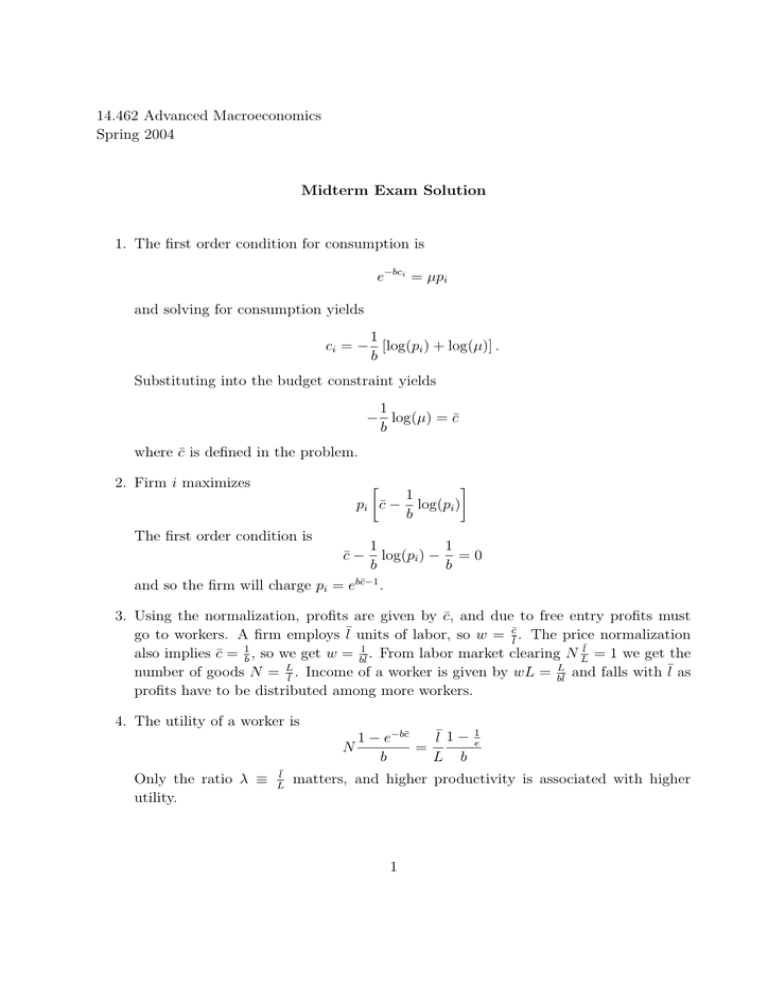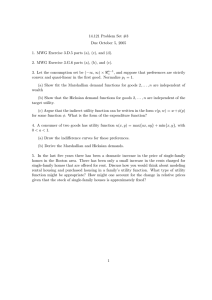14.462 Advanced Macroeconomics Spring 2004 Midterm Exam Solution
advertisement

14.462 Advanced Macroeconomics Spring 2004 Midterm Exam Solution 1. The first order condition for consumption is e−bci = µpi and solving for consumption yields 1 ci = − [log(pi ) + log(µ)] . b Substituting into the budget constraint yields 1 − log(µ) = c̄ b where c̄ is defined in the problem. 2. Firm i maximizes � � 1 pi c̄ − log(pi ) b The first order condition is 1 1 log(pi ) − = 0 b b b¯ c− 1 and so the firm will charge pi = e . c̄ − 3. Using the normalization, profits are given by c̄, and due to free entry profits must go to workers. A firm employs ¯l units of labor, so w = c̄l̄ . The price normalization also implies c̄ = 1b , so we get w = b1l̄ . From labor market clearing N Ll̄ = 1 we get the number of goods N = Ll̄ . Income of a worker is given by wL = bLl̄ and falls with ¯l as profits have to be distributed among more workers. 4. The utility of a worker is Only the ratio λ ≡ utility. l̄ L ¯l 1 − 1 − e−bc̄ N = b L b 1 e matters, and higher productivity is associated with higher 1 5. Managers receive what is left of profits after workers have been paid: ω(q) = ¯l 1 −w b q 6. The left hand side is the supply of workers, the right hand side is the demand for workers. Again only the ratio λ = Ll̄ matters, and differentiating this yields � qmax f (q) dq ∂q ∗ q∗ � q � = ∂λ f (q ∗ ) 1 + λ q∗ Using the equation implicitly defining q ∗ one can also write ∂q ∗ λ F (q ∗ ) = ∂λ q ∗ f (q ∗ ) [q ∗ + λ] Substituting the assumed distribution function and density yields ∂q ∗ λ q ∗ − qmin = ∗ < 1, ∂λ q ∗ q +λ which insures that ¯ l q∗ is increasing in ¯l. 7. The manager with ability q ∗ must be indifferent between managing and working, so we must have ¯l 1 wL = − w ∗ b q and so w= 1 b L+ We can write wL = ¯ l q∗ 1 b 1+ λ q∗ 8. The absolute wage level clearly falls. The number of firms and thus the number of managers is N = 1 − F (q ∗ ) and falls. If income is R, then utility is R 1 − e−b N U (R, N ) = N b We already know that the income of a worker wL falls, which reduces utility. We also know that N falls. It remains to show that the fall in N also reduces utility. We have � � ∂U 1 R = g b ∂N b N 2 where g(x) = 1 − e−x − xe−x . We have g(0) = 0 and g � (x) = 1 + xe−x , so utility is increasing in N . We have ω(q) 1 λ λ λ = − =1+ ∗ − q wL bwL q q Define � h(λ, q) = 1 + λ We have 1 1 − ∗ q (λ) q � . ∂h(λ, q) 1 1 1 ∂q ∗ = ∗ − −λ ∗ 2 ∂λ q (λ) q (q ) ∂λ Evaluating this at q = q ∗ yields 1 ∂q ∗ ∂h(λ, q ∗ ) = −λ ∗ 2 < 0, ∂λ (q ) ∂λ so inequality between workers and low-quality managers falls. Now 1 ∂ 2 h(λ, q) = 2 ∂λ∂q q and � � ∂h(λ, q) 1 ∂q ∗ λ lim = ∗ 1− > 0, q→∞ ∂λ (q ∗ ∂λ q (λ) so inequality between production workers and high-quality managers increases (al­ though qmax may not be high enough to have an increase in inequality). Finally we have ω(q � ) h(q � , λ) = ω(q) h(q, λ) and this will be increasing if the elasticity � � ∗ 1 1 − − λ2 (q∗1)2 ∂q λ q ∗ (λ) q ∂λ ∂h λ � � = 1 ∂λ h 1+λ −1 q ∗ (λ) q is increasing in q. This is the case if � � � �� � � � ∗ λ 1 1 λ 1 1 2 1 ∂q 1+λ ∗ −λ ∗ 2 >0 − − 2 λ ∗ − q2 q (λ) q q q (λ) q (q ) ∂λ which is satisfied. 3






